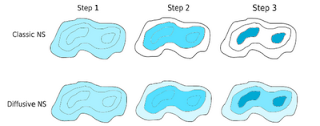For our first session of the semester two great planets and our moon as well as farther, wider objects will be in view.
Jupiter, one of the top two planets to see in any telescope, will be setting just as we arrive on the rooftop. At 5 pm it won't yet be dusk, so the sun's glare may prevent us from viewing Jupiter's four giant moons. We will need luck in order to catch the planet in the telescope.
Will anyone bring binoculars? In any case we can get acquainted with the planet using just our eyes.
Our Moon is the most fabulous object to view at night through the telescope. On Sunday it is a waxing gibbous, an excellent time to zero in on the landing sites of some of the Apollo missions! (Sorry, we can't see the flags.)
Next, as we peer at a cloudy white region known as the Great Nebula in Orion, we can imagine it is the birth of our own sun - probably similar stars are being born there now!
Mars will be on the rise as we prepare to exit the premises. While it may not be viewable in the scope, we can identify the planet for next week; its position won't change much in that time!
Remember to dress warmly as the observatory is outdoors! While waiting for your turn to view you may wish to wait in the warmer hallway.
If the weather isn't clear then we will cancel.
Follow the announcements at
AlbanyStarGaze 
for updates.
--
Phil Erner
PhD student, SUNY Albany.












Note: We will be bringing pictures of the event and updates.
Previously we had some nice moon pictures...
here.







